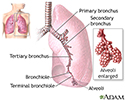Paraquat poisoning
Paraquat lung
Paraquat (dipyridylium) is a highly toxic weed killer (herbicide). In the past, the United States encouraged Mexico to use it to destroy marijuana plants. Later, research showed this herbicide was dangerous to workers who applied it to the plants.
This article discusses the health problems that can occur from swallowing or breathing in paraquat.
This article is for information only. DO NOT use it to treat or manage an actual poison exposure. If you or someone you are with has an exposure, call your local emergency number (such as 911), or your local poison control center can be reached directly by calling the national toll-free Poison Help hotline (1-800-222-1222) from anywhere in the United States.
Causes
In the United States, paraquat is classified as "restricted commercial use." People must obtain a license to use the product.
Breathing in paraquat may cause lung damage and can lead to a disease called paraquat lung. Paraquat causes damage to the body when it touches the lining of the mouth, stomach, or intestines. You can get sick if paraquat touches a cut on your skin. Paraquat may also damage the kidneys, liver, and esophagus (the tube that food goes down from your mouth to your stomach).
If paraquat is swallowed, death can quickly occur. Death may occur from a hole in the esophagus, or from severe inflammation of the area that surrounds the major blood vessels and airways in the middle of the chest (mediastinum).
Long-term exposure to paraquat may cause scarring of the lungs called pulmonary fibrosis. This makes it hard to breathe.
Symptoms
Symptoms of paraquat poisoning include:
- Burns and pain in the throat
- Choking
- Coma (lack of responsiveness)
- Difficulty breathing
- Nosebleed
- Seizures
- Shock (extremely low blood pressure)
- Shortness of breath
- Stomach pain
- Vomiting, including vomiting blood
Exams and Tests
You will be asked if you have been exposed to paraquat. Take the container with you to the hospital, if possible.
Your health care provider will measure and monitor your vital signs, including temperature, pulse, breathing rate, and blood pressure. Tests that may be done include:
- Blood and urine tests
- Chest x-ray
- Electrocardiogram (ECG)
- Bronchoscopy (tube through the mouth and throat ) to view any lung damage
- Endoscopy (tube through the mouth and throat ) to look for any damage to the esophagus and stomach
Treatment
There is no specific treatment for paraquat poisoning. The goal is to relieve symptoms and treat complications. If you are exposed, first aid measures include:
- Removing all contaminated clothing.
- If the chemical touched your skin, wash the area with soap and water for 15 minutes. Do not scrub hard, because that could break your skin and let more of the paraquat absorb into your body.
- If the paraquat got into your eyes, flush them with water for 15 minutes.
- If you have swallowed paraquat, get treated with activated charcoal as quickly as possible in order to decrease the amount absorbed in the gastrointestinal tract. Sicker people may need a procedure called hemoperfusion, which filters the blood through charcoal to try to remove paraquat from the lungs.
At the hospital, you will likely receive:
- Activated charcoal by mouth or a tube through the nose into the stomach if the person presents for help within an hour of ingesting the poison
- Breathing support, including oxygen, tube through the mouth into the lungs, and breathing machine (ventilator)
- Fluids through a vein (IV)
- Medicine to treat symptoms
Outlook (Prognosis)
The outcome depends on how severe the exposure is. Some people may develop mild breathing-related symptoms and have a full recovery. Others may have permanent changes in their lungs. If a person swallowed the poison, death is likely without immediate medical care.
Possible Complications
These complications can occur from paraquat poisoning:
- Lung failure
- Holes or burns in the esophagus
- Inflammation and infection in the chest cavity, affecting vital organs and blood vessels
- Kidney failure
- Scarring of the lungs
When to Contact a Medical Professional
If you believe you have been exposed to paraquat, seek medical care right away.
Your local poison control center can be reached directly by calling the national toll-free Poison Help hotline (1-800-222-1222) from anywhere in the United States. This national hotline number will let you talk to experts in poisoning. They will give you further instructions.
This is a free and confidential service. All local poison control centers in the United States use this national number. You should call if you have any questions about poisoning or poison prevention. It does NOT need to be an emergency. You can call for any reason, 24 hours a day, 7 days a week.
Prevention
Read labels on all chemical products. Do not use any that contain paraquat. Stay away from areas where it may be used. Keep all poisons in their original container and out of reach from children.
References
Kuschner WG, Blanc PD. Acute responses to toxic exposures. In: Broaddus VC, Ernst JD, King TE, et al, eds. Murray and Nadel's Textbook of Respiratory Medicine. 6th ed. Philadelphia, PA: Elsevier; 2022:chap 103.
Welker KL, Thompson TM. Pesticides. In: Walls RM, ed. Rosen's Emergency Medicine: Concepts and Clinical Practice. 10th ed. Philadelphia, PA: Elsevier; 2023:chap 152.
Review Date: 7/1/2023









